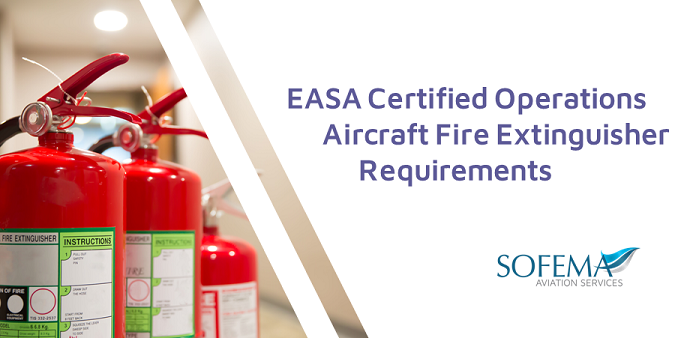EASA Certified Operations Aircraft Fire Extinguisher Requirements Reviewed by Sofema Aviation Services (SAS) www.sassofia.com
Introduction
To comply with CAT.IDE.A.250 – Hand Fire Extinguishers
Aeroplanes shall be equipped with:
- At least one hand fire extinguisher in the flight crew compartment.
- At least one hand fire extinguisher shall be located in, or readily accessible for use in, each galley not located on the main passenger compartment.
- At least one hand fire extinguisher shall be available for use in each class A or class B cargo or baggage compartment and in each class E cargo compartment that is accessible to crew members in flight.
Classification System
Certification standards (e.g. FAA Part 25 of EASA CS-25) are defining Cargo compartment classifications:
- Class A and Class B are cargo compartments accessible to a crew member.
- A Class A cargo or baggage compartment is one in which the presence of a fire would be easily discovered by a crewmember while at the station and each part of the compartment is easily accessible in flight.
- A Class B compartment (see § 25.857(b)) is accessible in flight but more remote from the crewmember’s station than a Class A compartment and must, therefore, incorporate a smoke or fire detection system to give warning at the pilot or flight engineer station.
- Class C and Class D are cargo compartments not accessible to a crew member.
- Class E is a cargo compartment on aeroplanes used only for the carriage of cargo.
- Class F is a cargo compartment located on the main deck and fitted with means to extinguish or control a fire without requiring a crewmember to enter the compartment.
Type & Quantity of Fire Extinguishers
The type and quantity of extinguishing agent for the required fire extinguishers shall be suitable for the type of fire likely to occur in the compartment where the extinguisher is intended to be used and to minimise the hazard of toxic gas concentration in compartments occupied by persons.
Typical Fire extinguishers include
- Halon 1211 (BromoChlorodiFluoromethane also known as ‘BCF’) or equivalent fire extinguishers are spaced throughout the cabin and easily accessible from the aisle or entryway.
- A water fire extinguisher is typically located near a lavatory-galley complex.
o Note – Halon 1301 is used only in fixed extinguisher installations typically cargo holds or engines and is a total flooding agent.
Minimum Number of Hand Fire Extinguishers – Maximum Operational Passenger Seating Configuration: MOPSC
| PAX Nos | Extinguisher Nos |
| 7-30 | 1 |
| 31-60 | 2 |
| 61-200 | 3 |
| 201-300 | 4 |
| 301-400 | 5 |
| 401-500 | 6 |
| 501-600 | 7 |
| 601 or more | 8 |
General Notes
- Where only one hand fire extinguisher is required in the passenger compartments, it should be located near the cabin crew member’s station, where provided.
- Where two or more hand fire extinguishers are required in the passenger compartments and their location is not otherwise dictated by consideration of CAT.IDE.A.250(b), an extinguisher should be located near each end of the cabin with the remainder distributed throughout the cabin as evenly as is practicable.
- Unless an extinguisher is clearly visible, its location should be indicated by a placard or sign. Appropriate symbols may also be used to supplement such a placard or sign.
Next Steps
Follow this link to our Library to find & Download related documents for Free.
Sofema Aviation Services offers over 550 Regulatory Compliant & Vocational Training Course for details please see www.sassofia.com for online courses please see www.sofemaonline.com for questions and additional guidance please email team@sassofia.com
Tags:
Aircraft, BCF, Cargo compartment classifications, CAT.IDE.A.250, Classification System, EASA, EASA Certified Operations, EASA CS-25, FAA Part 25, Fire Extinguisher, Fire Safety, Flight Crew, Hand Fire Extinguisher, MOPSC, Requirements, SAS blogs




